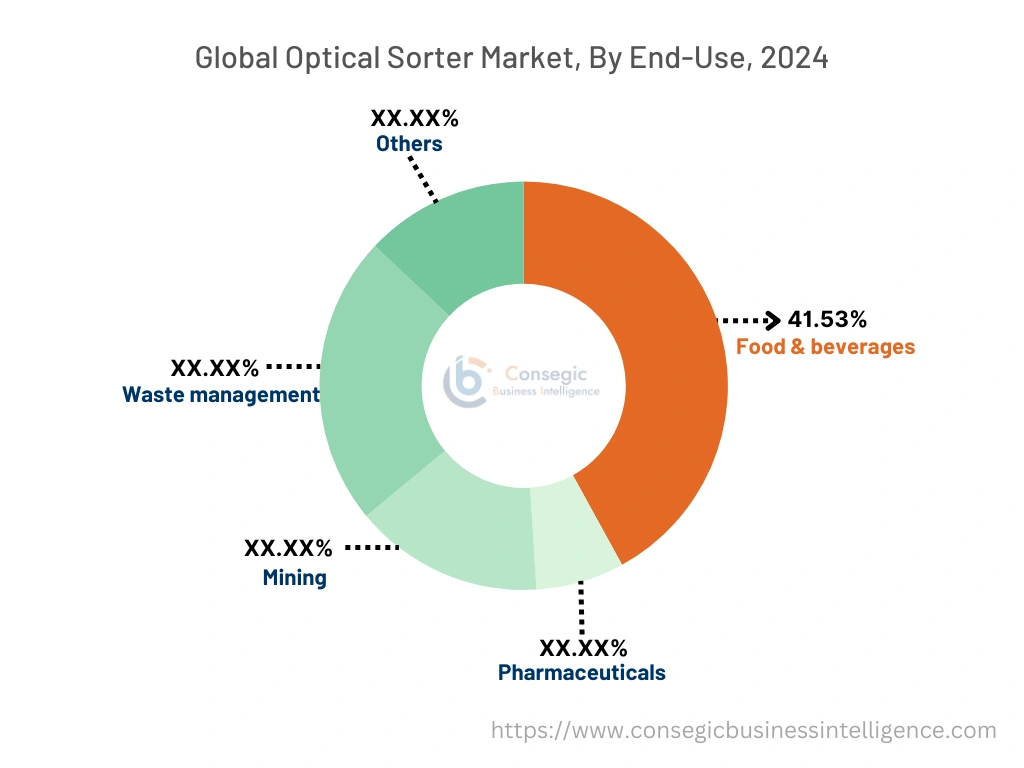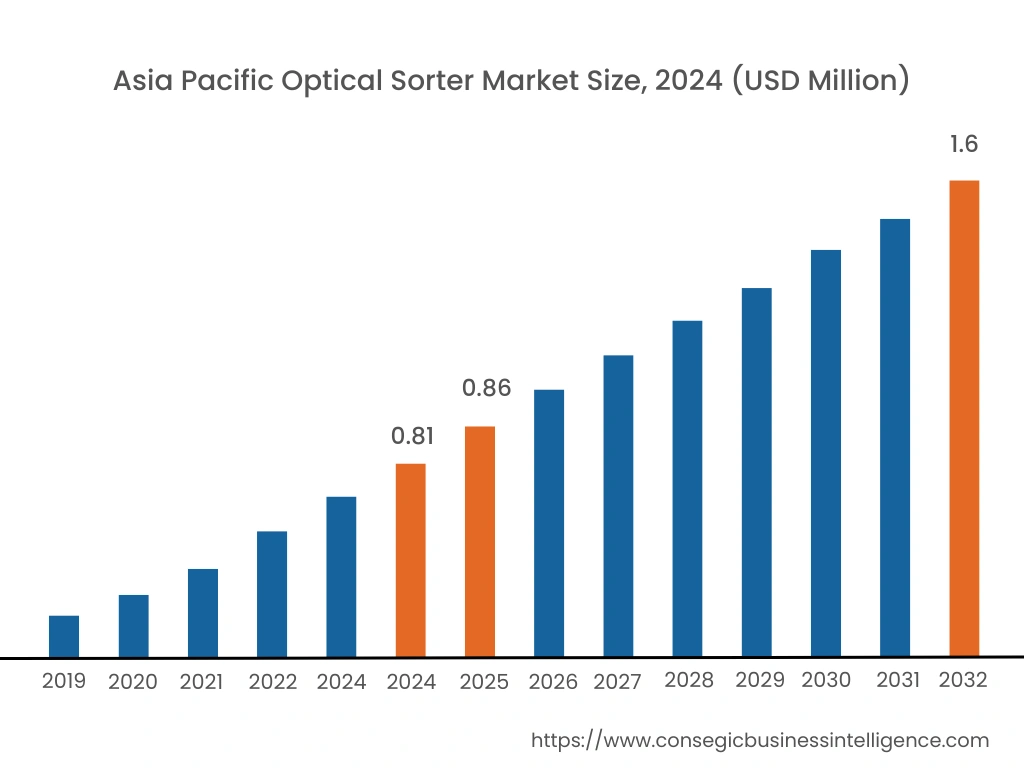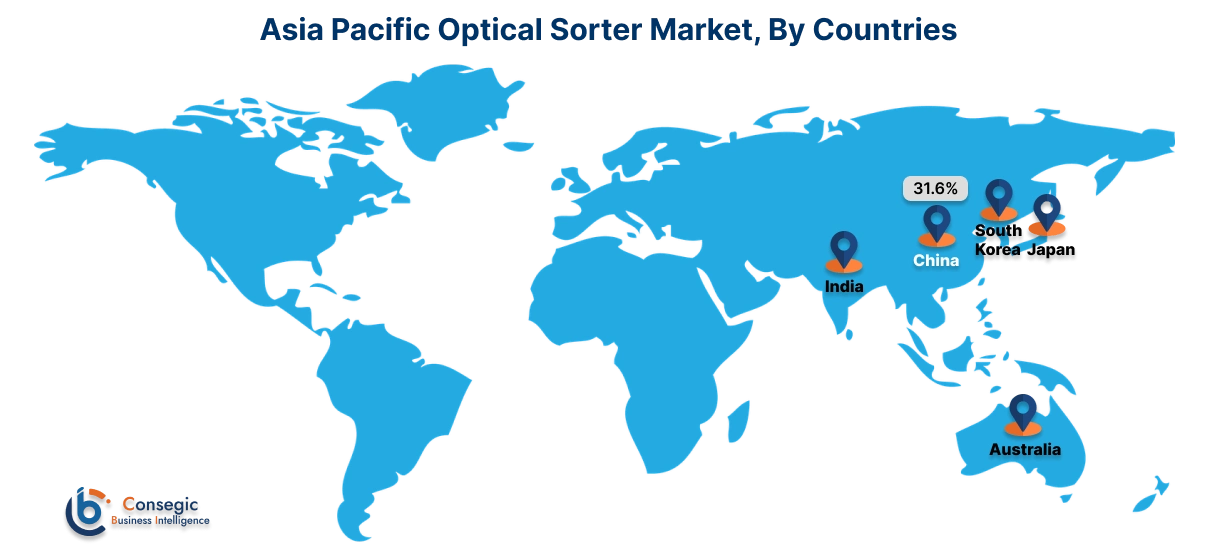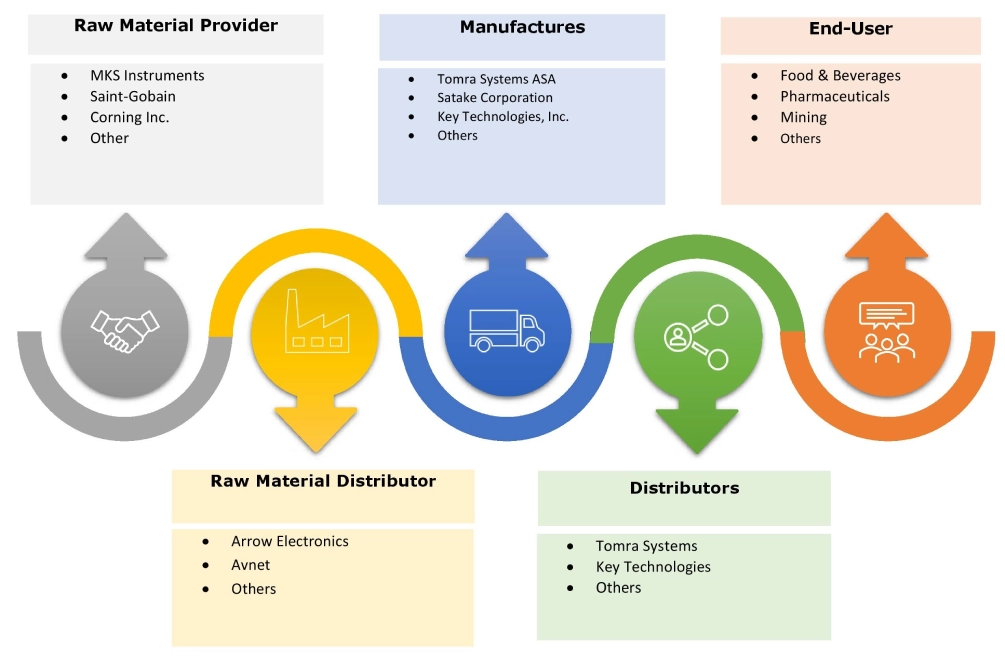- Summary
- Table Of Content
- Methodology
Optical Sorter Market Size:
Optical Sorter Market size is estimated to reach over USD 5.24 Billion by 2032 from a value of USD 2.74 Billion in 2024 and is projected to grow by USD 2.92 Billion in 2025, growing at a CAGR of 8.5% from 2025 to 2032.
Optical Sorter Market Scope & Overview:
An optical sorter is an automated machine utilized to sort products with advanced imaging technology which includes components such as cameras and lasers among others to sort products. The optical sorter is used in industries including food processing, pharmaceuticals, and agriculture among others to enhance product quality by identifying and removing defective products and foreign materials. Moreover, the benefits of adopting optical sorting include improved accuracy, increased throughput, enhanced product quality, and reduced labor cost. Further, the rising need for automation in industrial processes to enhance operational efficiency and minimize human error is also driving the market demand.
Optical Sorter Market Dynamics - (DRO) :

Key Drivers:
Surge in Demand for Automation in E-commerce and Logistics Industry Boosting Market Growth
Rapid industrialization is driving the need for automation in various industries including food processing, manufacturing, and others to enhance productivity and efficiency. Moreover, automation helps in handling various tasks by collaborating between multiple machines which significantly boosts efficiency and productivity, in turn driving the demand for automation in optical sorting machines. Further, the technological advancement in automation such as the integration of artificial intelligence, machine learning, and the Internet of Things for remote monitoring and control is spurring the optical sorter market growth.
- In October 2023, Ambi Robotics partnered with Pitney Bowes Inc. to deploy AmbiSort B-Series modular parcel induction and sorting solution for middle-mile operations. The partnership aims to advance e-commerce and logistics operations with the help of automation and emerging technologies.
Therefore, the rising need for automation and emerging technology is driving the e-commerce and logistics industry which in turn is proliferating the optical sorter market size.
Key Restraints :
The Limited Material Spectrum is restraining the growth of the market
The optical sorting machine distinguishes objects based on color and shape but does not sort items based on texture, thus limiting its effectiveness, particularly in the food & beverages sector. Additionally, the presence of moisture in materials like food grains and ores further restricts their use, hindering market growth.
Therefore, the limitations associated with the compatibility of machines with various materials are hindering market expansion.
Future Opportunities :
Integration of Artificial Intelligence into Optical Sorter Promotes New Opportunities for Market Growth
Emerging technology such as artificial intelligence integrated into optical sorting machines helps enhance efficiency, productivity, and accuracy in various industries. Artificial Intelligence helps in optimizing the complex algorithms involved in the optical sorting machine. Moreover, AI ensures rapid detection of materials and defects which eliminates the chance of human error which in turn drives the optical sorter market growth.
- In January 2024, SWEEEP Kuusakoski partnered with Recycleye to deploy an optical sorting machine that uses AI and machine learning to innovatively sort e-waste for recycling.
Hence, the integration of AI into optical sorting machines is anticipated to promote potential optical sorter market opportunities during the forecast period.
Optical Sorter Market Segmental Analysis :
By Technology:
Based on technology, the market is segmented into cameras, lasers, NIR sorters, hyperspectral cameras, combined sorters, and others.
Trends in the technology:
- Integration of AI into hyperspectral cameras improves the ability to separate and recognize materials which in turn improves the performance of optical sorting machines.
- Multiple sensors such as cameras, lasers, near-infrared (NIR) sensors, and others easily integrate with optical sorting machines which enhances the capabilities of color sorting machines.
The camera accounted for the largest revenue share in the year 2024.
- Optical sorting machine utilizes cameras to eliminate human error and cater to the growing requirements for identifying, analyzing, and sorting materials based on color, size, and other physical characteristics. Additionally, the camera technology has a higher resolution which accurately identifies small defects and spots on the raw material, and with a high-precision dedicated lens can ensure a clear image.
- The primary factor driving the development of the camera segment is the technological ability to enhance efficiency, improve inspection, and reduce the time required in the overall operation.
- In May 2023, Specim launched GX17 for optical sorting machine which enhances the efficiency with accuracy, and inspection along with reduced operational time.
- Thus, as per the analysis, the rising adoption of camera technology for improving efficiency and accuracy is driving the optical sorter market trends.
The NIR sorter is anticipated to register the fastest CAGR during the forecast period.
- NIR sorter utilizes near-infrared light to absorb the light spectrum emitted by the objects of specific functional groups. The wavelength used by the NIR sorter technology ranges from 780 nm to 2526 nm. Moreover, technology is highly efficient in distinguishing different materials, regardless of color and shape.
- The food processing sector is driving the demand for NIR sorters due to the cutting-edge technology for recycling and processing grains and others.
- In April 2023, National Recovery Technologies (NRT) launched a new SpydIR-HS optical sorter which utilizes a near-infrared (NIR) platform for enhancing detection resolution, improving the air ejection precision and easily integrating with a visual identification system.
- Therefore, the ability of NIR sorters to distinguish different materials, regardless of color and shape is anticipated to boost the market during the forecast period.
By Platform:
Based on the platform, the market is segmented into belt, freefall, lane, and hybrid.
Trends in the platform
- The growing trend towards reducing food waste and improving efficiencies is boosting the need for freefall-based optical sorting machines.
- Integration of machine learning into sorting machines is enhancing the ability of machines to adapt to the changing requirements and select platforms based on requirements.
The belt segment accounted for the largest revenue share in the year 2024.
- Belt based optical sorting machine is a device that utilizes photoelectric detection technology for automatically sorting out mixed particles based on the differences in the optical characteristics of the materials.
- Moreover, a belt belt-based optical sorting machine is suitable for applications in food processing companies of nuts, seafood, dried fruits, fresh fruits, and vegetables.
- Additionally, the AI-powered sorter integrates advanced visible light sorting technologies into belt based optical sorting machine is also driving the evolution of the market
- In August 2023, DTDC Express Ltd selected Falcon Autotech cross-belt sorter technology for automating the parcel sorting operations of its facility in Chennai, Tamil Nadu, and the facility is about 1,75,000 sq. ft.
- Thus, as per the analysis, the advancement and integration of AI into optical sorting machines are driving the belt-based optical sorter market demand.
The hybrid segment is anticipated to register the fastest CAGR during the forecast period.
- The hybrid optical sorting machine combines various sorting platforms such as belt, freefall, and lane depending on the requirement for increasing flexibility and efficiency. Additionally, a hybrid optical sorting machine is preferable for complicated task that involves varied materials with advanced features.
- Further, the advancement in the hybrid optical sorting machine by combining various platforms is increasing the development of segments. Moreover, the machine involves features such as optical detection, electroporation, and others.
- In May 2023, Geek+ collaborated with NEXT's Dearne Valley Pallet fulfillment center to automate the 45,000m2 of warehouse space. The collaboration has deployed a hybrid Pick-and-Sort solution with 250 Geek+ robots.
- Therefore, the advancement and ability to handle various materials with different features are anticipated to boost the progress of the market during the forecast period.
By Application:
Based on the application, the market is segmented into food processing, recycling, minerals & precious metals sorting, tablets & capsules inspection process, and others.
Trends in the application :
- The sorting machine is increasingly adopted in airports for improving the operational efficiency of baggage sorting.
- The growing mining sector and rising need for detecting ores with different colors, such as copper oxide, crystalline structures in quartz, and others are boosting the optical sorter market size.
Food processing accounted for the largest revenue share in the year 2024 and is anticipated to register the fastest CAGR during the forecast period.
- Optical sorting machines are utilized in food processing and other industrial applications which require easy cleaning to prevent cross-contamination and convenient access for maintenance.
- In May 2024, Tolsma-Grisnich partnered with Invaro Group to enhance the efficiency of optical sorting of potatoes and onions. Additionally, Tolsma-Grisnich is assigned with all the commercial and service activities and Invaro Group is assigned to focus on the development and production of optical technology and machinery.
- Hence, according to the optical sorter market analysis, the rising need for preventing cross-contamination and convenience in food processing is driving the need for the optical sorter market.
By End-Use:
Based on the end use, the market is segmented into food & beverages, pharmaceuticals, mining, waste management, and others.
Trends in the end-use:
- The new regulatory landscape pushes companies to adopt optical sorting machines in waste management to reduce plastic waste driving the optical sorter market trend.
- New technologies in optical sorters such as cameras, capacity sensors, and odor reduction systems are helping companies to decrease energy use, save money, and increase operational efficiency.
Food & beverages accounted for the largest revenue share of 41.53% in the year 2024.
- The rising need for high-quality food products with a shorter delivery cycle is driving the progress of the food and beverages segment in the optical sorter market share. Further, the growing automation and stringent rules and regulations in the food & beverages sector are also driving the evolution of the segment.
- Moreover, crops such as maize are particularly prone to aflatoxin contamination, classified as a primary carcinogen which is dangerous to health optical sorting machine helps in the identification of contamination and thus increases the safety of the food chain.
- In June 2021, Satake Corporation launched NIRAMI, an optical sorting machine for grains, pulses, seeds, and many other products.
- Thus, the need for high-quality food products and growing automation as well as stringent rules and regulations in the food and beverages sector is driving the need for optical sorting machines.
The Waste Management is anticipated to register the fastest CAGR during the forecast period.
- The rising need for reducing the impact of waste on the environment and the increasing focus of businesses towards sustainability is propelling the need for optical sorting machines in the waste management segment.
- Additionally, stringent rules and regulations in waste management are propelling the need for optical sorting.
- Moreover, optical sorting machine utilizes AI image recognition technology and sensors in waste management. The technology allows precise identification and separation of waste materials for improving the efficiency and productivity of machines.
- In July 2024, Renewi partnered with Freepoint Eco-Systems to develop new waste plastic sorting and treatment infrastructure. The partnership aims to establish the pre-processing infrastructure, for the supply of 80,000 tons of feedstock for Freepoint Eco-Systems.
- Therefore, the stringent rules and regulations and technological advancement in sorting machines are anticipated to boost the evolution of the market during the forecast period.

Regional Analysis:
The regions covered are North America, Europe, Asia Pacific, the Middle East and Africa, and Latin America.

Asia Pacific region was valued at USD 0.81 Billion in 2024. Moreover, it is projected to grow by USD 0.86 Billion in 2025 and reach over USD 1.6 Billion by 2032. Out of this, China accounted for the maximum revenue share of 31.6%. As per the optical sorter market analysis, rapid industrialization and urbanization in emerging countries such as China, India, and Japan are the primary factors fueling the market progress. Additionally, the stringent food safety rules and regulations as well as businesses shifting focus toward sustainability are driving the need for optical sorting machines to enhance productivity and adhere to safety norms in various industries.
- In September 2024, The Food Safety and Standards Authority of India (FSSAI) partnered with the Ministry of Agriculture and Livestock (MAPA) of Brazil by signing a MoU that aims at improving food safety through joint projects and technical collaboration. Hence, the stringent food safety rules and regulations are driving the optical sorter market share in the Asia Pacific region.

North America is estimated to reach over USD 1.7 Billion by 2032 from a value of USD 0.91 Billion in 2024 and is projected to grow by USD 0.97 Billion in 2025. The shifting focus towards automation across food processing, recycling, and mining sectors is the primary key factor driving the need for optical sorting machines. Moreover, the increasing labor cost and human errors in the production process are boosting the need for optical sorting. Additionally, the integration of AI into optical sorting is propelling market growth in North America.
- In June 2022, the Buhler group launched SORTEX H which is an optical sorting machine for wheat, rye, oats, grains, coffee, and pulses. The sorter utilizes the MerlinAI sorting algorithm for enhancing performance and product traceability.
The regional trends analysis depicts that the rising need for optical sorting machines in the food processing industry and stringent food safety rules and regulations in Europe are driving the optical sorter market expansion. The primary factor driving the market in the Middle East and African region is the rising demand for automated optical sorting machines to ensure compliance with safety norms as well as the rising need for solid waste management. Further, the expanding agricultural sector is increasingly adopting optical sorting machines to help enhance product quality, and operational efficiency and is paving the way for the growth of optical sorter market demand in the Latin America region.
Top Key Players & Market Share Insights:
The global optical sorter market is highly competitive with major players providing sorting machines to the national and international markets. Key players are adopting several strategies in research and development (R&D), product innovation, and end-user launches to hold a strong position in the optical sorter market. Key players in the optical sorter industry include-
- MSS Inc. (USA)
- Petkus Technologies GmbH (Germany)
- Optimum Sorting (Belgium)
- Hefei Meyer Optoelectronic Technology Inc. (China)
- Sesotec GmbH (Germany)
- Buhler Group (Switzerland)
- Tomra Systems ASA (Norway)
- Satake Corporation (USA)
- Key Technologies, Inc. (USA)
- Cimbria (Denmark)
Recent Industry Developments :
Product launches
- In August 2024, Key Technology launched COMPASS, an optical sorter of food, featuring next-generation inspection technology, an ergonomic user interface, and a new sort engine among others.
- In September 2024, Alstef Group launched XSORT, a cross-belt sorter designed for luggage handling at airports. The sorter delivers high-speed sorting solutions with efficiency and sustainability in operations.
Partnerships & Collaborations
- In February 2023, Ricova partnered with Pellenc ST and invested USD 6 Million to modernize equipment to achieve the operational target. Additionally, the new optical sorting machines have significantly reduced the level of contaminants from 35% to 2% in mixed paper.
- In September 2023, Cimbria partnered with OFI Weigh & Inspection Solutions for a dealership agreement for the sale of Cimbria’s SEA range of optical sorting machines in Australia.
Optical Sorter Market Report Insights :
| Report Attributes | Report Details |
| Study Timeline | 2019-2032 |
| Market Size in 2032 | USD 5.24 Billion |
| CAGR (2025-2032) | 8.5 % |
| By Technology |
|
| By Platform |
|
| By Application |
|
| By End-User |
|
| By Region |
|
| Key Players |
|
| North America | U.S. Canada Mexico |
| Europe | U.K. Germany France Spain Italy Russia Benelux Rest of Europe |
| APAC | China South Korea Japan India Australia ASEAN Rest of Asia-Pacific |
| Middle East and Africa | GCC Turkey South Africa Rest of MEA |
| LATAM | Brazil Argentina Chile Rest of LATAM |
| Report Coverage |
|
Key Questions Answered in the Report
How big is the optical sorter market? +
The Optical Sorter Market size is estimated to reach over USD 4.85 Billion by 2031 from a value of USD 2.58 Billion in 2023 and is projected to grow by USD 2.74 Billion in 2024, growing at a CAGR of 8.5% from 2023 to 2031.
What specific segmentation details are covered in the optical sorter report? +
The optical sorter report includes specific segmentation details for technology, platform, application, end-user, and regions.
Which is the fastest segment anticipated to impact the market growth? +
In the optical sorter market, the food processing segment is the fastest-growing segment during the forecast period due to rising food safety regulations as well as increasing collaboration between regions for advancing various processes involved in the industry is driving the services segment.
Who are the major players in the optical sorter market? +
The key participants in the optical sorter market are MSS Inc. (USA), Petkus Technologies GmbH (Germany), Buhler Group (Switzerland), Tomra Systems ASA (Norway), Satake Corporation (USA), Key Technologies, Inc. (USA), Cimbria (Denmark), Optimum Sorting (Belgium), Hefei Meyer Optoelectronic Technology Inc. (China), Sesotec GmbH (Germany) and others.
What are the key trends in the optical sorter Market? +
The optical sorter market is being shaped by several key trends including the technological advancement in the optical sorter with the integration of AI and Ml for improving efficiency and throughput in industries as well as cloud-based self-learning capabilities embedded in optical sorter are the key trends driving the market.


